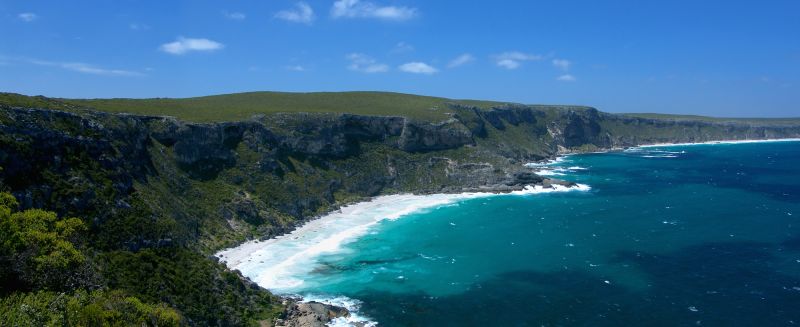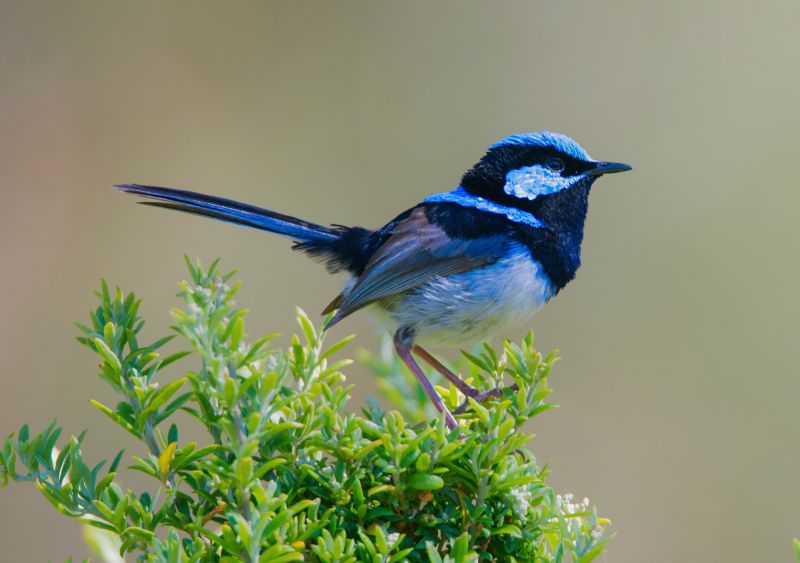Recently listed as one of the Top 5 Wildlife Guides by Outside Go magazine, Craig Wickham has always had a strong passion for wildlife conservation. Craig, along with his wife and family, has owned and operated Exceptional Kangaroo Island since 1990. We caught up with Craig recently to find out more about life on Kangaroo Island and what it means for him to be able to share his home with guests from around the world.
How long have you lived on Kangaroo Island?
Kangaroo Island is home. My family moved to the Island in 1967 when I was only one (year old). I grew up on a farm which was alongside a spectacular sandy beach, with great fishing, really interesting rocks to explore and a lot of wildlife in the vicinity.
The farm had a lot of bush, great birdlife, kangaroos, wallabies, goannas, possums and I spent a lot of time in the outdoors, so I guess that prepared me for the life that I’ve got now. I do a lot of indoor stuff, like marketing and business administration, but I never want to lose the opportunity of spending time outdoors - whether that is on my own, from a recreational sense, or doing it professionally as a guide, as I do a few times a week typically.
That’s something I really enjoy and its rewarding for me and for our guests.
 Snelling Beach - Craig's childhood home
Snelling Beach - Craig's childhood home
Can you tell me a little bit about life before Exceptional Kangaroo Island?
Life before Exceptional Kangaroo Island was a long time ago!
I was working for the National Parks and Wildlife Service and most of my work was in visitor services and environmental education. I did quite a bit of land management work as well, so pest control, fire management, facility development like lookouts, campgrounds, walking trails.
But the part of work that I really enjoyed most was spending time with people in nature and revealing things that they would not see on their own. Then the more time that I spent in nature with wildlife, the more I recognised behavioural patterns which were extremely interesting. The process of sharing this information with guests facilited that process.
I really wanted to be able to continue this and spend less time on the administration, so decided to take the opportunity to branch out on my own in 1990.
What do you enjoy most about your role as a wildlife guide?
As a guide, you have the privilege of being able to spend time pursuing your passion, but pursuing it with people who are there for the same reasons, with similar value sets. Our guests really enjoy learning about things that they wouldn’t otherwise know, seeing things they are less likely to find on their own and through storytelling, being enlightened about the links between different elements of the environment, or the environment and different members of our community...this paints a colourful picture of the destination.
Travel is really all about storytelling and people understanding the meanings and places and the human connections. Doing that with wildlife as the key vehicle is a special thing.
 Koalas are abundant on Kangaroo Island
Koalas are abundant on Kangaroo Island
Do you have a favourite location where you take your guests?
I’ve got different places that I enjoy for different reasons.
There’s a very quiet little beach called Boxing Bay that we (as a family) often go to in the summertime. We go down and have a meal in the evening and have a swim. There are often dolphins in the bay, coastal raptors soaring overhead, combined with some really interesting geology, so that’s a delightful spot.
The south-west corner of the island including Cape Du Couedic and Remarkable Rocks, is really diverse and spectacular. Along with the Long-nosed Fur-seals, I’ve seen Great White Sharks from the clifftops there. Often through the winter, we’ll also see whales, so all of those wildlife encounters in a spectacular coastal setting is good fun.
I guess I’m fortunate that there are many many favourite places and favourite things to do which we are able to share with our guests.
 Spectacular coastal scenery at Weirs Cove.
Spectacular coastal scenery at Weirs Cove.
What about wildlife, do you have a favourite species that you love showing your guests?
I guess I’m really keen on the birdlife, so sharing that is a joy for me.
But probably what is most rewarding, which might be a bit of surprise, is when we occasionally get the chance to observe Tiger Snakes, which are a really large terrestrial snake that are highly venomous and have a reputation of being dangerous and aggressive, within Australia. The everyday Australian would have that attitude towards Tiger Snakes.
I had this experience only last week, where I saw a snake that was about to cross the road, so we turned around and got out of the vehicle at a safe distance, and then quietly walked up and stood on the other side of the road. As we stood there, the snake came straight across (to our side of) the road. I prepared our guests by saying “let’s just stand perfectly still here quietly and observe this beautiful snake”, which was about 4 to 4.5 feet long. The snake came up, aware of us, and put it’s head up on a bit of a mound. It then flattened out and relaxed in the sun. We sat there and observed - and the guests just loved it. They said "we've never done that - at home in Arizona, we’ve got Rattlesnakes which are always seen as something to be feared. We've never taken the time to just sit and observe an animal." The snake was really relaxed and didn’t care about us at all. In fact, there was an empty beer bottle that I went to pick up to put in the vehicle to clean up the roadside and the snake didn’t even respond - and I was only a metre away.
So, I guess, those things where you can really change people’s perceptions of wildlife where, yes, it is a venomous snake but it is not necessarily dangerous because it depends on the context and depends very, very largely, not on the snake’s behaviour, but on our behaviour, on how we respond. We were relaxed and unthreatening, and the animal responded in kind.
Do you notice any common reactions among your guests when they visit?
I really like seeing the sheer delight on the faces of guests, when they experience things for the first time that they’d always dreamt about. Whether that is kangaroos hopping along, a Koala in the tree above, or some of our impossibly brightly coloured birds, the Rainbow Lorikeets, shooting through he treetops above us, or Galahs on the ground (pink and grey cockatoos) feeding on the grass seeds only a matter of 20-30 yards away from us.
Our guests just can’t believe the things we see out in the wild, having only seen these species on television or in a cage. They enjoy the combination of the sense of freedom of the wildlife being able to choose to go where they like, along with the privilege of sharing their space where we are just part of the landscape.
Seeing guests’ delight in experiencing contrasting habitats and diverse animals is pretty cool.
 Male Superb Blue-wren
Male Superb Blue-wren
What are the most surprising attributes of Kangaroo Island for guests?
The size is always a big surprise. Kangaroo Island is much, much larger than people anticipate.
Also, the diversity of landscape, the diversity of habitat and the diversity of encounters always surprises our guests, as well as the range of experiences that people can fit into a visit of only a few days.
Is there a ‘best time of year’ to visit?
We don’t have a whole lot of migration with wildlife on and around Kangaroo Island, with exception of some bird species that are migratory and the whales that are here in the winter (in the Southern Hemisphere summer they’re down in Antartica feeding on the krill).
Other than that, most of our wildlife (that people want to see in the wild) are here year-round, so we are able to operate year-round. We don’t have any times of the year that we don’t operate, so it really comes down to when people are visiting Australia and if they have been exposed to the compelling and enjoyable reasons to visit the island.
My personal preference is to experience the island in the cooler months, which for us is from May through to November. Depending on the season, when the opening rains come, the island is likely to be beautiful and green. The farmlands are green and growing, there are lots of wild flowers through our winter and spring time.
We share some of the 54 endemic plants, which means they’re found on Kangaroo Island and nowhere else. A lot of those plants are quite small and are more obvious when they’re flowering, so that’s my favourite time.
It’s always nice to be able to share these seasonal elements with our guests.
 The Spring time (September to November) is a beautiful time to visit Kangaroo Island.
The Spring time (September to November) is a beautiful time to visit Kangaroo Island.
Given you’ve spend most of your life there, have you noticed any changes to the ecosystem on Kangaroo Island?
We’re starting to see changes in water temperature, so that has impact on some of the species that we see.
The Blue Swimmer Crabs were once only found up in the gulfs (Spencer and St Vincent, off of mainland Australia) but are now increasingly seen around the waters of Kangaroo Island.
Arrival times of some of the migratory species is becoming a little more erratic.
The frequency of dry years (years with little rain) - four of the driest years on record happened in the last 15 years.To put that in context, there are some climate stations on Kangaroo Island that go back to about 1860 to 1870, so that is a reasonable reference point for what the normal climate period is.
Our average rainfall is lower than what it was when I was a kid, so that then has impact on how dry the country is. This has implications for bushfires, so there have been an increase in larger bushfires on Kangaroo Island in recent years. We’re seen increasing number of extreme weather days with wind as well, so we certainly are seeing some changes.
Is there anything new or exciting happening at Exceptional Kangaroo Island?
We’re not doing anything new as such, but we’ve got some new ways of exploring the island.
We’ve always had the ability to offer a range of experiences; whether that’s birdwatching, photography or immersive wildlife encounters, where we’re meeting up with some of the wildlife researchers to see what is happening behind the scenes on the island. Whether that is revegetation, wildlife surveys or some of the work being done for species like the Short-beaked Echidnas, Bottlenose Dolphins and Australian Sea-lions. We now have itineraries where people can take a trip where they are participating in these photographic, birdwatching or conservation-based activities.
They are now available on our website, so I guess our change has been about making it a little more accessible and ensuring people know about the opportunity to take part in those activities, in addition to our signature landscape and wildlife experiences across Kangaroo Island.


